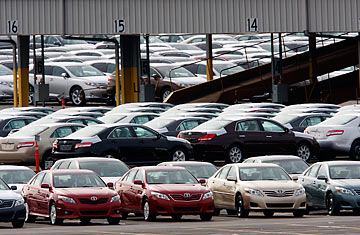
Toyota Camrys and Avalons sit ready to be shipped at the company's manufacturing plant in Georgetown, Ky.
For decades, Toyota and U.S. government agencies have been negotiating over a growing list of safety issues. Here is a history of major events pertaining to Toyota's acceleration-related problems.
September 1986: The National Highway Traffic Safety Administration, the government body in charge of keeping the roads safe, orders its first recall of Toyota cars because of "speed control" problems, according to the NHTSA database (though defects with the two 1982 models involved were related to faulty cruise control). A second investigation into sudden-acceleration dangers with Toyota vehicles takes place this year.
April 2003: Toyota internally deals with an "unwanted acceleration" incident that occurred during production testing of the Sienna. It determines the cause to be a missing clip that allowed the trim panel to trap the accelerator pedal. In the aftermath, Toyota concludes that it was an "isolated incident," according to the NHTSA report. Five years later, Toyota would inform the NHTSA about this incident when that administration makes a blanket information request.
March-July 2004: The NHTSA conducts what would be the first of many defect investigations regarding speed-control problems, all of which would lead to the current furor (partially about Toyota and the NHTSA's neglecting to pay attention to the abnormal number of investigations). The first three investigations primarily involve the Camry, Solara and Lexus ES models. The initial case is opened after an owner petitions the NHTSA in February to look into speed-control issues; it is closed when the NHTSA fails to find a "defect trend."
August 2005–January 2006: The NHTSA conducts a second evaluation after Jordan Ziprin, a Camry owner, reports "inappropriate and uncontrollable vehicle accelerations." In a subsequent questionnaire sent out to owners, hundreds of people report problems with acceleration and braking, but the NHTSA determines that their concerns are of "ambiguous significance" given the variety of defects described. Based on this sense of inconclusiveness, the administration denies Ziprin's petition for further investigate into the 19 Camry and Lexus models that are potentially involved.
September 2006–April 2007: The NHTSA conducts a third evaluation after William B. Jeffers III, another Camry owner, petitions the administration to investigate the multiple "engine surging" incidents that he has experienced. The NHTSA fails to identify any problems after reviewing the complaint and road-testing the petitioner's vehicle. It cites the need to best allocate limited administration resources as the reason for denying the petition.
March 2007: The NHTSA begins a fourth investigation into uncontrollable-acceleration problems with Lexus vehicles. In its preliminary evaluation, it suspects the floor mat to be the culprit.
July 2007: Troy Edwin Johnson is killed when a Camry accelerating out of control hits his car at approximately 120 m.p.h. The driver had been unable to slow the car for 23 miles leading up to the crash. Toyota eventually settles out of court with Johnson's family for an undisclosed amount.
August 2007: The NHTSA upgrades the investigation to an "engineering analysis," meaning it will do full-fledged vehicle testing instead of just reviewing complaints or single vehicles and crunching questionnaire numbers as it had done in the past. This leads to a floor-mat recall of the Camry and Lexus models in September. The NHTSA believes that 55,000 units may be affected.
January 2008–August 2008: The NHTSA denies the petition of a Toyota Tacoma owner who has asked the agency to investigate the unwanted sudden acceleration he experienced. It finds the possibility of a defect to be "quite limited."
